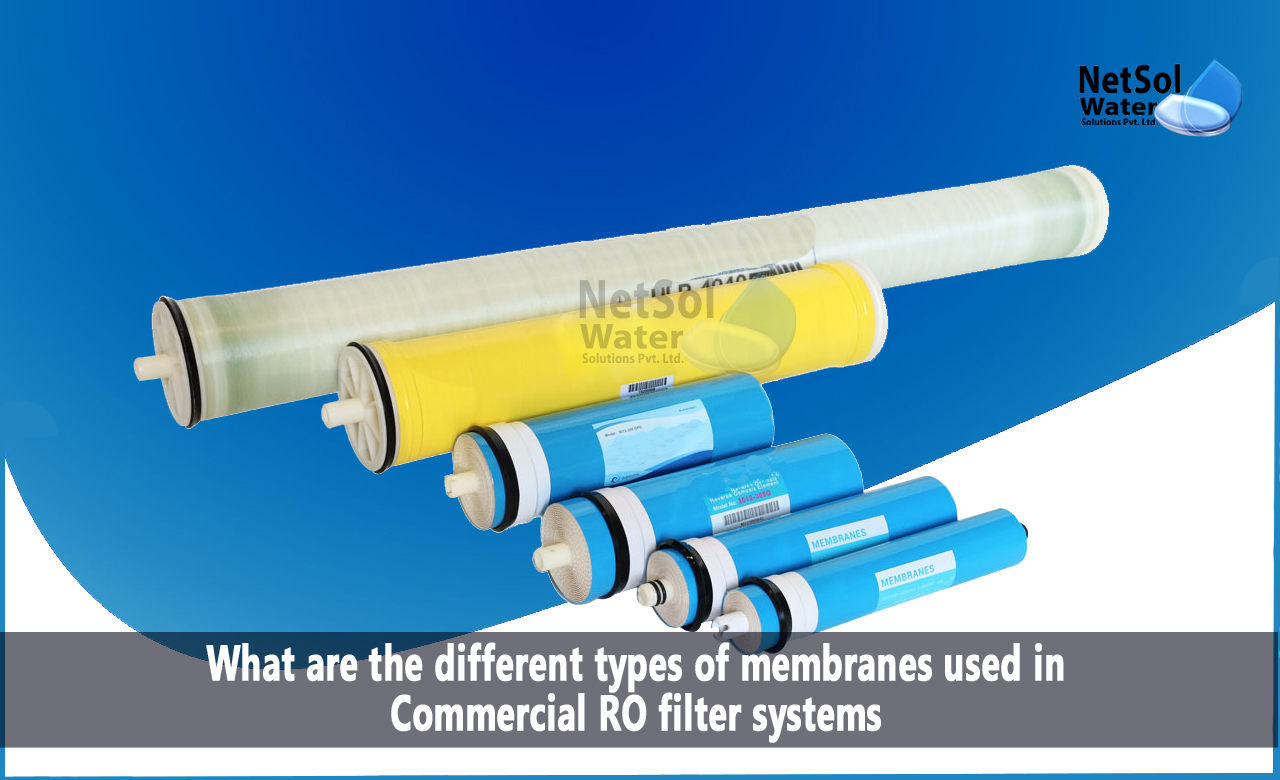What are the different types of membranes used in Commercial RO filter?
Reverse osmosis membranes are crucial components for managing wastewater and water. Membranes are extremely thin sheets of synthetic plastic with incredibly small pores. The membranes used in Reverse Osmosis RO water purifiers have the smallest pores; in fact, their pores are only slightly larger than the size of a water molecule. As a result, they easily permit the passage of pure water molecules while blocking the passage of larger salt and organic chemical molecules.
By membrane pore size, there are three more membrane types that are frequently employed in industry: microfiltration (MF), ultrafiltration (UF), and nanofiltration (NF). To achieve the goals of the Drinking Water laws and standards for water and wastewater treatment, these four membrane types are frequently utilized. Desalinated and/or Ultra Pure Water (UPW) is processed using a reverse osmosis membrane for a variety of industrial and other purposes, including repurposing water from power plants for the food industry, pharmaceutical industry, medical sector, and others.
Types of membranes used in commercial RO filter system:
1. Membrane types categorized by filtration type:
· Microfiltration:
Microfiltration operates between 7 and 100 kPa and filters out particles larger than 0.08-2 m. Removing bacteria prepares the water for successful disinfection, removing residual suspended solids (SS), and serving as a pre-treatment stage for reverse osmosis.[5]
Membrane bioreactors (MBR), which combine microfiltration and a bioreactor for biological therapy, are a relatively new invention.
· Ultrafiltration
Ultrafiltration operates between 70 and 700 kPa and eliminates particles larger than 0.005-2 m. Many of the same uses for microfiltration also apply to ultrafiltration. Proteins and carbohydrates, two dissolved substances with high molecular weights, have been removed using several ultrafiltration membranes. They can also eliminate certain endotoxins and viruses.
· Nanofiltration
Nanofiltration (NF), commonly referred to as "loose" RO, may filter out particles as small as 0,002 m. Selected dissolved components of wastewater are removed using nanofiltration. In contrast to chemical softening, NF is primarily developed as a membrane softening method.
Similar to this, directed reverse osmosis can be employed as a pre-treatment before nanofiltration. The three main goals of NF pre-treatment are to:
(1). lower the operating pressure of the RO process by lowering the concentration of feed-water total dissolved solids (TDS);
(2). prevent scaling by removing the hardness ions; and
(3). prevent particulate and microbial fouling of the RO membranes by removing turbidity and bacteria.
· Reverse osmosis
Desalination frequently uses reverse osmosis. Additionally, the removal of dissolved components from wastewater that is still present after advanced treatment with microfiltration is a popular application for RO technology. Although RO eliminates ions, it requires high pressures (between 850 and 7000 kPa) to generate deionized water. Due to its ease of use and comparably cheap energy costs to distillation, which relies on technology based on thermal processes, RO is the most used desalination technology. It should be noted that RO membranes eliminate ions from water. To do this, the majority of modern RO systems employ a thin-film composite (TFC), which primarily consists of three layers: a polyamide layer, a polysulphone layer, and a polyester layer.
2. Membrane types based on membrane shape:
There are many different membrane configurations, but spirally coiled hollow fibre membranes are the most common. The type of membrane chosen affects the device's performance and overall effectiveness. This comprises:
· Plates and frames: In a plate-like device that collects solids, these membranes are positioned inside a carrier plate. They may be less effective than other filtration techniques and have a low packing density, but they are typically simpler to use and clean. Usually applied to difficult-to-filter solutions. They are also among the more expensive systems but cheaper membranes.
· Spiral wound membranes: Spiral wound membranes are among the most frequently utilised. They are made up of flat membrane sheets sandwiched between spacers that resemble mesh, which are looped around a central tube (which collects the filtrate after filtration) and set inside a casing. They can be employed in high-volume applications with low suspended particles and are reasonably small.
· Tubular: A pipe or shell is lined with a number of tube-like membranes, and as a stream passes through them, the permeate is transferred to the pipe or shell side. TDS, TSS, oil, fat, and fatty ones are frequently employed for problematic streams but can become less permeable at low packing densities.
3. Membrane types categorized by structure:
Thin film composite (TFC or TFM) membranes and cellulose triacetate (CTA) membranes are two popular forms of RO membranes. Filtering capability and chlorine resistance are the key variations between the two types. CTA membranes can withstand chlorine, however they are prone to bacterial contamination and only remove 93% of common contaminants. TFC/TFM membranes can only treat water that is chlorine-free but typically remove 98% of common pollutants and are less prone to organic pollution. Use a carbon pre-treatment filter with a TFC/TFM membrane to purify chlorinated tap water. Membranes for brackish water, salt water, and brine can be utilised in municipal, industrial, and marine desalination applications.
Do you need an advice or assistance on selecting the best water and waste water treatment unit? We have solutions for all your problems!
Let us now your problem, our experts will make sure that it goes away.
For an assistance or related query,
Call on +91-965-060-8473
Or write us at enquiry@netsolwater.com



